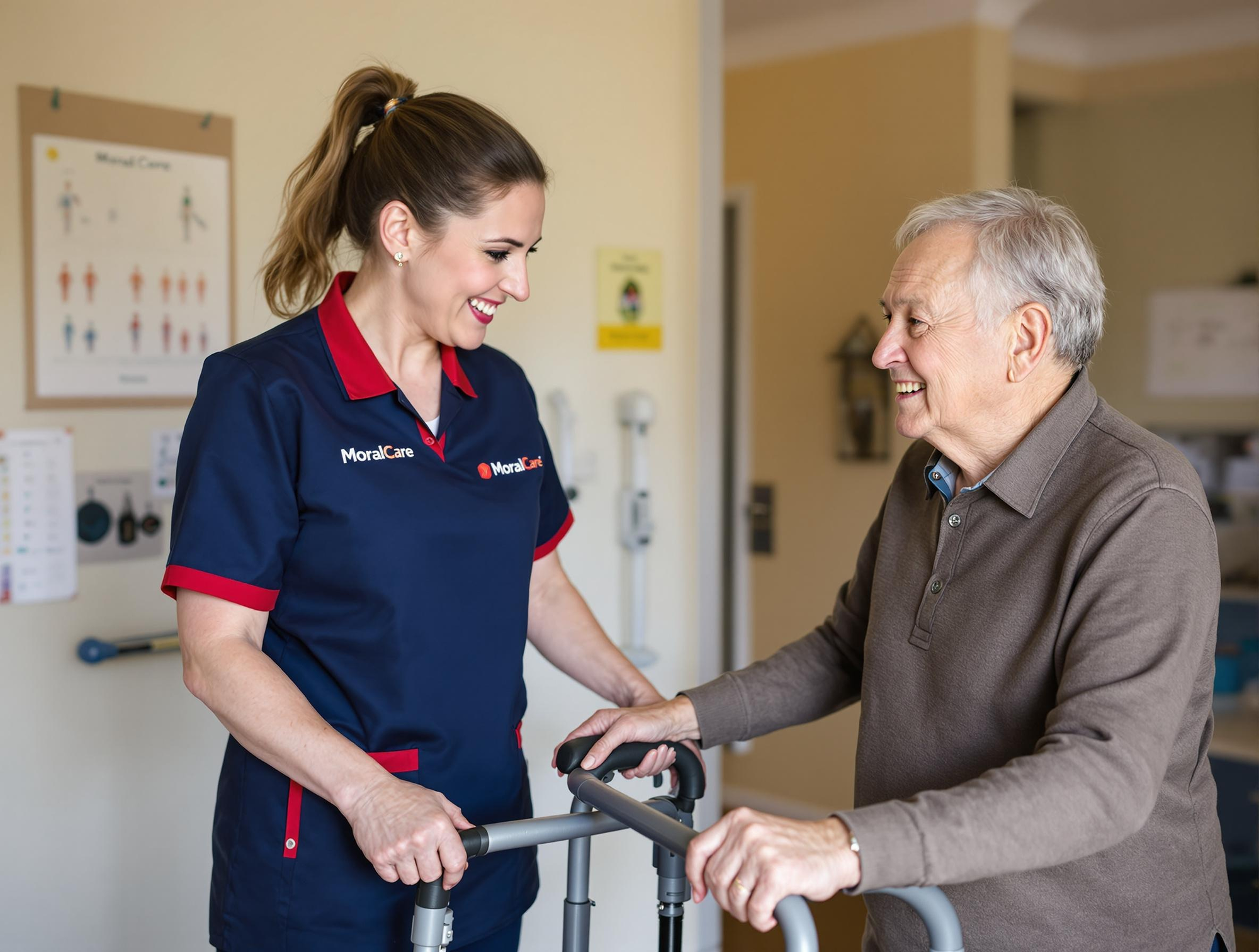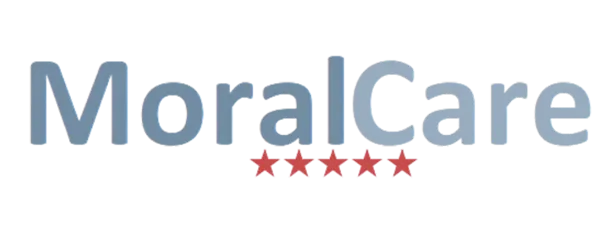Stroke Reablement: Rebuilding Independence After Stroke at Home

Recovering from a stroke is one of life's most challenging journeys, but with the right support, understanding, and professional reablement services, it's possible to regain independence and rebuild a fulfilling life at home. At MoralCare, our reablement specialists understand that stroke recovery isn't just about medical care—it's about restoring confidence, relearning skills, and adapting to new ways of living whilst maintaining dignity and hope for the future.
Understanding Stroke and Its Impact
What is a Stroke?
A stroke occurs when blood flow to part of the brain is interrupted, either by a blocked blood vessel (ischemic stroke) or bleeding in the brain (hemorrhagic stroke). This interruption deprives brain cells of oxygen and nutrients, causing them to die within minutes.
UK Stroke Statistics:
Someone has a stroke every 5 minutes in the UK
Stroke is the fourth leading cause of death
Over 1.3 million stroke survivors live in the UK
Two-thirds of stroke survivors leave hospital with a disability
150,000 people have strokes each year
Types of Stroke:
Ischemic stroke (85%): Caused by blocked arteries
Hemorrhagic stroke (15%): Caused by bleeding in the brain
Transient Ischemic Attack (TIA): "Mini-stroke" with temporary symptoms
The Immediate Impact of Stroke
Physical Effects:
Weakness or paralysis on one side of the body (hemiplegia/hemiparesis)
Balance and coordination problems
Difficulty walking or moving
Swallowing difficulties (dysphagia)
Vision problems
Fatigue and reduced stamina
Cognitive Effects:
Memory problems
Difficulty concentrating
Reduced problem-solving abilities
Confusion and disorientation
Executive function difficulties
Communication Effects:
Aphasia (difficulty understanding or expressing language)
Dysarthria (difficulty speaking clearly)
Reading and writing difficulties
Understanding complex instructions
Emotional Effects:
Depression and anxiety
Mood swings and emotional lability
Loss of confidence
Frustration and anger
Fear of another stroke
What is Stroke Reablement?
Defining Reablement
Reablement is a person-centred approach that focuses on helping stroke survivors regain skills, confidence, and independence in their daily activities. Unlike traditional care that does things for people, reablement works with individuals to help them do things for themselves.
Core Principles of Reablement:
"Doing with, not doing for" - Supporting independence rather than creating dependency
Goal-oriented approach - Working towards specific, meaningful objectives
Time-limited intervention - Intensive support for a defined period
Skills-focused - Rebuilding abilities rather than managing disabilities
Person-centred - Tailored to individual needs, preferences, and goals
The Difference Between Care and Reablement
Traditional Care Approach:
Focuses on what people cannot do
Provides services to compensate for disabilities
Creates dependency on care services
Maintains current functioning level
Long-term service provision
Reablement Approach:
Focuses on what people can do and want to achieve
Teaches skills and strategies for independence
Builds confidence and self-reliance
Aims to improve functioning and independence
Time-limited with clear goals and outcomes
The Stroke Recovery Journey
Acute Phase (First Few Days)
Hospital Focus:
Medical stabilisation
Preventing complications
Initial assessment of abilities
Early mobilisation when safe
Swallowing assessment
Family Preparation:
Understanding the stroke and its effects
Learning about recovery expectations
Preparing for discharge planning
Emotional support and counselling
Introduction to stroke services
Early Recovery (First 3-6 Months)
Neuroplasticity Window:
Brain's greatest capacity for recovery
Intensive rehabilitation most effective
New neural pathways can develop
Skills can be relearned and adapted
Maximum potential for improvement
Key Recovery Areas:
Physical function and mobility
Communication and speech
Cognitive abilities
Daily living skills
Emotional adjustment
Ongoing Recovery (6 Months+)
Continued Improvement:
Recovery can continue for years
Slower but meaningful progress
Adaptation and compensation strategies
Maintenance of gained skills
Prevention of complications
MoralCare's Stroke Reablement Approach
Comprehensive Assessment
Initial Evaluation:
Pre-stroke abilities and lifestyle
Current physical and cognitive function
Communication abilities
Personal goals and priorities
Home environment assessment
Family support systems
Ongoing Assessment:
Regular progress monitoring
Goal adjustment as needed
Identification of new challenges
Celebration of achievements
Planning for next steps
Personalised Goal Setting
SMART Goals:
Specific: Clear, well-defined objectives
Measurable: Trackable progress indicators
Achievable: Realistic and attainable
Relevant: Meaningful to the individual
Time-bound: Clear timeframes for achievement
Example Goals:
"Walk independently to the kitchen within 4 weeks"
"Prepare a simple meal safely within 6 weeks"
"Manage medication independently within 3 weeks"
"Communicate basic needs clearly within 2 weeks"
Multidisciplinary Approach
Professional Team:
Reablement specialists
Physiotherapists
Occupational therapists
Speech and language therapists
Dietitians
Social workers
Coordination:
Regular team meetings
Shared care plans
Progress monitoring
Goal adjustment
Family involvement
Physical Reablement After Stroke
Mobility and Movement
Common Challenges:
Weakness on one side of the body
Balance problems
Coordination difficulties
Reduced stamina
Fear of falling
Reablement Strategies:
Gradual mobility progression
Safe transfer techniques
Balance training exercises
Strength building activities
Confidence building approaches
Practical Interventions:
Walking practice with appropriate aids
Stair climbing when safe and appropriate
Transfer training (bed to chair, chair to standing)
Balance exercises and activities
Endurance building
Activities of Daily Living
Personal Care Reablement:
Washing and bathing independently
Dressing and undressing
Grooming and personal hygiene
Toilet transfers and management
Medication self-administration
Adaptive Techniques:
One-handed dressing methods
Bathroom safety adaptations
Grooming aid usage
Modified personal care routines
Energy conservation strategies
Equipment and Adaptations:
Grab rails and support bars
Shower seats and bath boards
Long-handled reaching aids
Adaptive clothing and fastenings
Non-slip mats and surfaces
Kitchen Skills and Meal Preparation
Nutritional Independence:
Safe food preparation
Cooking with one hand
Kitchen safety awareness
Meal planning and shopping
Nutritional knowledge
Practical Skills:
Using adaptive kitchen equipment
Safe appliance operation
Food storage and hygiene
Simple meal preparation
Emergency procedures
Safety Considerations:
Hot surface awareness
Sharp object handling
Gas and electrical safety
Fire prevention
Emergency contact systems
Communication Reablement
Understanding Aphasia
Types of Aphasia:
Broca's aphasia: Difficulty expressing thoughts
Wernicke's aphasia: Difficulty understanding language
Global aphasia: Severe difficulties with both expression and comprehension
Anomic aphasia: Difficulty finding specific words
Communication Strategies
Supporting Expression:
Allowing time for responses
Using simple, clear language
Encouraging gesture and pointing
Using visual aids and pictures
Celebrating communication attempts
Enhancing Understanding:
Speaking slowly and clearly
Using familiar words and phrases
Providing visual cues
Checking understanding regularly
Reducing background noise
Technology Support:
Communication apps and devices
Picture communication boards
Voice amplifiers
Text-to-speech software
Video calling for family contact
Cognitive Reablement
Memory and Thinking Skills
Common Challenges:
Short-term memory problems
Difficulty concentrating
Reduced problem-solving abilities
Executive function difficulties
Confusion and disorientation
Reablement Strategies:
Memory aids and prompts
Routine establishment
Step-by-step task breakdown
Cognitive exercises and activities
Environmental modifications
Practical Support:
Daily planners and calendars
Medication reminder systems
Labelling and organisation
Routine establishment
Mental stimulation activities
Executive Function Support
Planning and Organisation:
Task sequencing support
Priority setting assistance
Time management strategies
Decision-making support
Problem-solving techniques
Practical Applications:
Daily routine planning
Activity scheduling
Goal setting and monitoring
Safety awareness
Independence building
Emotional and Psychological Reablement
Understanding Post-Stroke Emotions
Common Emotional Challenges:
Depression (affects 30-50% of stroke survivors)
Anxiety and fear
Grief for lost abilities
Frustration and anger
Loss of confidence and self-esteem
Emotional Lability:
Sudden, uncontrolled emotional outbursts
Crying or laughing inappropriately
Emotional responses that don't match feelings
Difficulty controlling emotional reactions
Building Emotional Resilience
Psychological Support:
Validation of feelings and experiences
Encouragement and positive reinforcement
Goal achievement celebration
Confidence building activities
Peer support connections
Practical Strategies:
Gradual challenge progression
Success experience creation
Meaningful activity engagement
Social connection maintenance
Future planning and hope building
Family and Carer Support
Supporting Families:
Education about stroke effects
Communication strategy training
Emotional support and counselling
Respite care provision
Future planning assistance
Relationship Rebuilding:
Communication improvement
Role adjustment support
Intimacy and relationship counselling
Family dynamic understanding
Shared goal setting
Home Environment Adaptations
Safety Modifications
Fall Prevention:
Remove trip hazards and clutter
Improve lighting throughout the home
Install grab rails and handrails
Ensure clear pathways
Secure loose rugs and carpets
Bathroom Safety:
Shower seats and bath boards
Grab rails near toilet and bath
Non-slip mats and surfaces
Raised toilet seats
Easy-access shower controls
Kitchen Adaptations:
Lower work surfaces where needed
Easy-grip handles and controls
Good lighting over work areas
Accessible storage solutions
Safety equipment (smoke alarms, fire blankets)
Accessibility Improvements
Mobility Adaptations:
Ramps for wheelchair or walking aid access
Stairlifts where appropriate
Wider doorways if needed
Accessible parking spaces
Level access showers
Daily Living Aids:
Reaching and grabbing tools
Adaptive cutlery and utensils
Large-button telephones
Easy-grip door handles
Automatic lighting systems
Technology in Stroke Reablement
Assistive Technology
Mobility Support:
Walking aids and mobility scooters
Stairlifts and platform lifts
Transfer boards and hoists
Wheelchair adaptations
Vehicle modifications
Communication Technology:
Speech-generating devices
Communication apps
Voice recognition software
Large-button phones
Video calling systems
Daily Living Technology:
Medication reminder systems
Automatic pill dispensers
Smart home controls
Emergency alert systems
Activity monitoring devices
Rehabilitation Technology
Physical Rehabilitation:
Virtual reality therapy systems
Robotic-assisted therapy
Functional electrical stimulation
Balance training systems
Strength training equipment
Cognitive Rehabilitation:
Brain training apps and games
Memory enhancement software
Attention training programs
Problem-solving applications
Executive function tools
Measuring Progress in Stroke Reablement
Assessment Tools
Functional Assessments:
Barthel Index (activities of daily living)
Modified Rankin Scale (disability level)
Functional Independence Measure
Canadian Occupational Performance Measure
Goal Attainment Scaling
Quality of Life Measures:
Stroke-Specific Quality of Life Scale
EuroQol-5D
Life satisfaction measures
Mood and depression scales
Confidence and self-efficacy measures
Progress Monitoring
Regular Reviews:
Weekly goal assessment
Monthly comprehensive reviews
Quarterly outcome evaluations
Annual long-term assessments
Continuous family feedback
Outcome Tracking:
Functional improvement measures
Independence level changes
Quality of life improvements
Goal achievement rates
Service reduction indicators
The Role of Family in Stroke Reablement
Family as Partners
Collaborative Approach:
Shared goal setting
Progress celebration
Challenge problem-solving
Future planning
Emotional support provision
Family Education:
Understanding stroke effects
Learning support techniques
Recognising progress signs
Managing expectations
Accessing resources
Supporting Family Wellbeing
Carer Support:
Respite care provision
Emotional support services
Practical training
Peer support groups
Professional counselling
Family Dynamics:
Role adjustment support
Communication improvement
Relationship rebuilding
Conflict resolution
Future planning
Nutrition and Hydration in Stroke Recovery
Swallowing Difficulties (Dysphagia)
Assessment and Management:
Professional swallowing assessment
Texture modification when needed
Safe swallowing techniques
Positioning during meals
Monitoring for aspiration risk
Nutritional Support:
Adequate calorie and protein intake
Vitamin and mineral supplementation
Hydration monitoring
Weight management
Appetite stimulation
Meal Preparation Reablement
Kitchen Skills:
One-handed cooking techniques
Safe food preparation
Adaptive equipment usage
Meal planning skills
Shopping strategies
Nutritional Education:
Stroke prevention diet
Heart-healthy eating
Blood pressure management
Diabetes control if relevant
Medication-food interactions
Preventing Secondary Strokes
Risk Factor Management
Medical Management:
Blood pressure control
Cholesterol management
Diabetes control
Atrial fibrillation treatment
Medication compliance
Lifestyle Modifications:
Smoking cessation
Alcohol moderation
Regular exercise
Healthy diet
Weight management
Education and Awareness
Warning Signs Recognition:
FAST (Face, Arms, Speech, Time) awareness
When to call emergency services
Medication importance
Regular medical follow-up
Risk factor monitoring
Long-term Outcomes and Success Stories
Measuring Success
Functional Outcomes:
Increased independence in daily activities
Improved mobility and movement
Better communication abilities
Enhanced cognitive function
Reduced care needs
Quality of Life Improvements:
Increased confidence and self-esteem
Better mood and emotional wellbeing
Enhanced social participation
Meaningful activity engagement
Future planning and hope
Real-World Impact
Individual Success:
Return to meaningful activities
Maintained relationships
Continued learning and growth
Community participation
Personal goal achievement
Family Benefits:
Reduced carer burden
Improved family relationships
Increased confidence in supporting
Better quality of life for all
Future security and planning

Comments